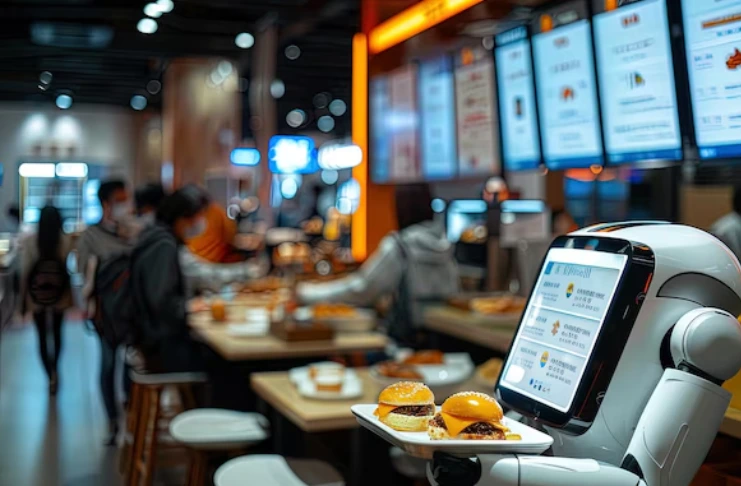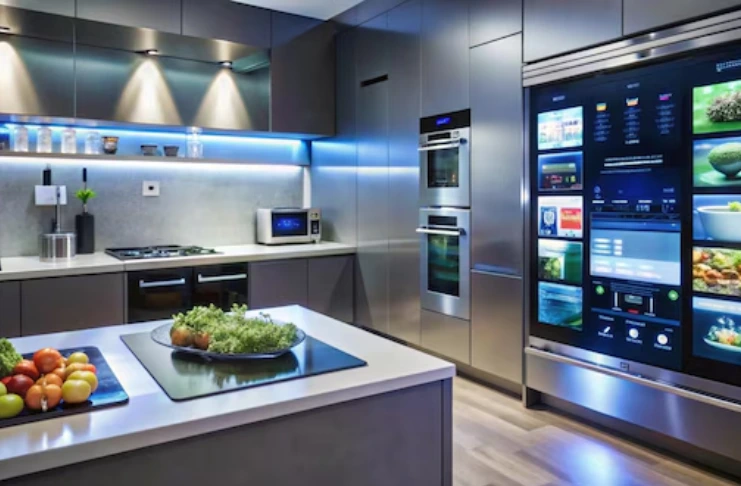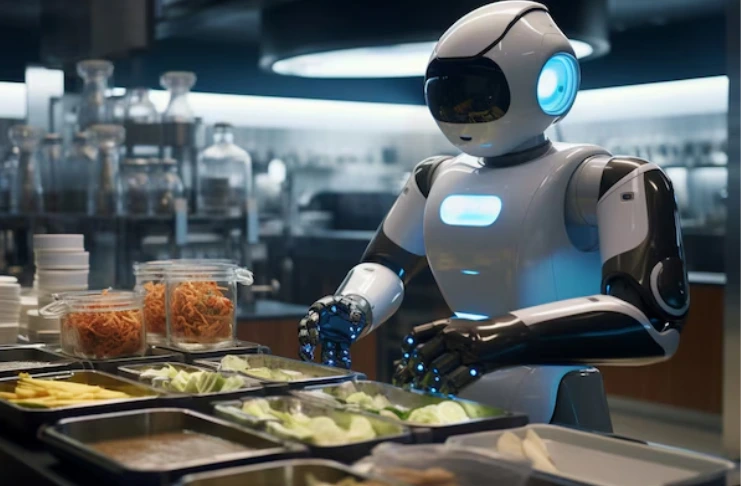
Picture this: It’s a busy evening at your restaurant. The dining room is packed, the kitchen is buzzing with activity, and orders are flying in faster than ever. As the owner, you’re juggling a million tasks—ensuring the kitchen is stocked, managing staff, and keeping an eye on the quality of every dish that leaves the pass. It feels like you’re trying to spin plates while walking a tightrope, and the pressure is on. But what if there was a way to manage all these moving parts effortlessly?
Restaurant technology has come a long way from simple cash registers. Today, it’s the backbone of efficient operations, acting as a central command center that keeps everything running smoothly.
The responsibilities can seem overwhelming, from sourcing high-quality ingredients from reliable vendors to ensuring the kitchen never runs out of stock and monitoring staff performance. But with the right technology, you can streamline every aspect of your restaurant’s operations, giving you the control and confidence to manage your business efficiently.
Technology isn’t just a tool—it’s your partner in success. It helps you keep a tight grip on all activities, allowing you to focus on what matters: delivering an exceptional dining experience to your customers. In this blog, we’ll look at how technology can help restaurants streamline their operations and improve overall efficiency.
Leveraging Smart Tech to Streamline Kitchen Operations:

The kitchen is the heart of any restaurant, and it’s where technology can make a significant impact. Modern kitchen technology goes beyond essential appliances; it integrates intelligent systems that enhance efficiency, reduce waste, and ensure consistency in food quality.
Smart Kitchen Equipment
Innovations like programmable ovens and IoT-enabled refrigerators are transforming kitchen operations. These devices allow chefs to optimize cooking processes by setting precise temperatures and timings, ensuring consistent results.
IoT-enabled refrigerators monitor temperature and humidity levels in real-time, alerting staff to potential issues before they escalate, thus minimizing spoilage and ensuring food safety.
Kitchen Display Systems (KDS)
KDS is another game-changer, replacing traditional paper tickets with digital displays. This system reduces paper waste and streamlines communication between kitchen and front-of-house staff.
With KDS, orders are displayed in real time, prioritized based on cooking times, and tracked for efficiency. This leads to faster service, reduced errors, and improved customer satisfaction.
Precision and Sustainability: AI’s Role in Inventory Management:
Mastering inventory management is crucial for the restaurant industry’s success. Conventional methods relying on manual stock counts are time-consuming and prone to errors. AI-powered inventory management offers an automated and optimized solution for your business needs.
Automated Stock Management
AI-driven systems analyze usage patterns, predict future inventory needs, and automate reordering processes. This saves time and ensures that the right ingredients are always on hand, reducing the risk of running out of stock or overordering.
Reducing Food Waste
AI can also suggest menu changes based on ingredient availability, helping restaurants minimize waste and control costs. For example, if a particular ingredient is nearing its expiration date, the system might recommend a special dish that uses it, turning potential waste into revenue.
Sustainability
Implementing AI-powered inventory management aligns with growing sustainability trends in the restaurant industry. By reducing waste and optimizing stock levels, restaurants can lower their environmental footprint and appeal to eco-conscious customers.
Informed Decision-Making Through Data Analytics:

Data is one of the most valuable assets for any business in this digital age, and the restaurant industry is no exception. With a growing wealth of data from sources like loyalty programs, mobile apps, and purchase histories, data analytics has become essential.
Understanding Customer Behavior
Restaurants can use data analytics to gain insights into customer preferences, dining habits, and spending patterns. For instance, knowing that 51% of Americans eat out at least once a week and 43% use apps to order takeout multiple times can help restaurateurs tailor their offerings and marketing strategies to meet demand.
Optimizing Staffing and Operations
Data analytics can also help restaurants make informed staffing decisions. By analyzing patterns in customer traffic, restaurants can optimize their workforce to ensure they are adequately staffed during peak hours while avoiding overstaffing during slower periods.
Personalizing the Dining Experience
Personalization is a growing trend in the restaurant industry. With data analytics, restaurants can create personalized dining experiences by offering targeted promotions, customized menu suggestions, and loyalty rewards based on individual customer preferences. This not only enhances customer satisfaction but also builds long-term loyalty.
Automation Revolution: A Game-Changer for Restaurants:
One of the most pressing challenges confronting the restaurant industry today is the need for more staff. Technology provides a solution through automation, easing staffing pressures and enhancing operational efficiency.
Automated Ordering and Payment Systems:
Self-service kiosks and mobile ordering apps are becoming increasingly popular in restaurants. These systems allow customers to place orders and make payments without direct interaction with staff, speeding up the ordering process and reducing the demand for front-of-house staff.
Robotic Assistance in the Kitchen

Robots and automated systems are also making their way into the kitchen. From robotic chefs who can prepare simple dishes to automated dishwashers, these technologies help reduce the workload on kitchen staff, allowing them to focus on more complex tasks.
Labor Cost Management
By implementing automation, restaurants can optimize labor costs by reallocating staff to areas where they are needed most, reducing the impact of staffing shortages and improving overall efficiency.
Data-Driven Marketing Strategies:
Effective marketing drives sales and attracts new customers in a fiercely competitive market. Fortunately, technology empowers restaurants with the tools they need to create targeted, data-driven marketing campaigns.
Utilizing Customer Data for Targeted Marketing

With access to vast amounts of customer data, restaurants can create highly targeted marketing campaigns that resonate with specific customer segments. For example, if data shows that a particular demographic likes to order takeout on weekdays, a restaurant can send targeted promotions to encourage repeat business.
Social Media and Digital Marketing
Social media platforms and digital marketing tools allow restaurants to reach a broader audience and personally engage with customers. By leveraging these tools, restaurants can build their brand, attract new customers, and retain existing ones.
Loyalty Programs and Promotions
Loyalty programs are an effective way to encourage repeat business and build customer loyalty. By integrating loyalty programs with their POS systems, restaurants can track customer activity and offer personalized rewards and promotions, driving customer retention and increasing sales.
Navigating Digital Transformation for Restaurants: A Strategic Approach
In today’s competitive landscape, restaurant owners are faced with a plethora of digital solutions, and to maximize return on investment, it’s crucial to adopt a strategic approach:
1. Define Your Digital Destination:
Identify Pain Points: Identify areas where technology can significantly improve your operations and customer experience. Are you grappling with inventory management, slow order processing, or customer retention?
- Set Clear Goals: Establish measurable objectives that align with your restaurant’s overall strategy. For example, do you aim to increase revenue by 20% or improve customer satisfaction by 50%?
2. Build a Technology Roadmap:
- Prioritize Investments: Create a phased plan that addresses your most pressing needs. Start with solutions that offer the quickest return on investment.
- Consider Scalability: Choose technologies that can grow with your business. Avoid solutions that become limiting factors as your restaurant expands.
3. Empower Your Team:
- Invest in Training: Ensure your staff has the skills to use new technologies effectively. Provide comprehensive training programs that address both technical aspects and the benefits of digital transformation.
- Foster Adoption: Highlight how new tools can simplify their work and enhance job satisfaction to encourage employee buy-in.
Conclusion
As we navigate the relentless march of transformative technology reshaping the restaurant industry, it’s clear that the future holds unprecedented opportunities for innovation and efficiency. However, in this rush to digitize, the true challenge is to strike a delicate balance between technological advancement and the personal touch that makes dining out a memorable experience.
While keeping your tech stack up to date is critical, the most successful restaurants match their technology choices to their specific needs, always keeping sight of the personal service customers crave. By striking this balance, you’ll create a dining experience that’s both cutting-edge and uniquely yours—a recipe for long-term success in a constantly changing industry.








